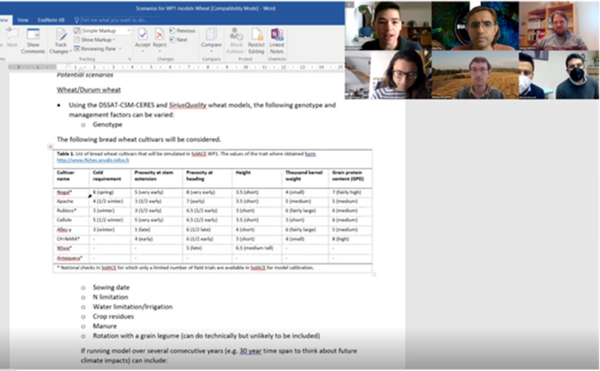In a newsletter article in September 2020, we revealed our plans for the approach the SolACE modelling group will take to capture the impact of future climates on the interactions between crop varieties (genotypes), changing environments and management strategies to achieve agricultural sustainability in Europe. Part of this strategy was to engage with the SolACE farmer networks to assess priorities for future scenario testing. This engagement was very successful and has now provided us with a range of priority scenarios to test.
Through interactions with Amelia Magistrali of Newcastle University in work package 5 (Co-assessment of novel crop genotypes and management innovations in farmers networks), SolACE modellers discussed the preferences of farmer groups with farmer network leads at three regular crop network meetings (potato, durum wheat and bread wheat groups). Some common themes from across the seven farmer networks emerged, with all groups interested in the impacts of future water limitations and restricted nitrogen inputs. There was also interest in the potential impact of changes in genotypes of the focus crops, particularly in understanding the impact of potato varieties with long roots and the use of more traditional varieties of bread wheat. These considerations will now become the focus for the SolACE modellers in their scenario testing activities.
There were also some nuances in the priorities of the different farmer networks. For the potato group, the interest in water was specific to understanding the optimal timing of irrigation in future climates, and there was also some interest in understanding the impact of altered disease stress. The durum and bread wheat groups emphasised understanding the opportunity for avoidance of water stress in these rain-fed crops by altering the sowing date. The wheat groups were also interested in the impact of heat stress and competing weeds on the yield of their crops. Where possible, these additional considerations will be investigated by the SolACE modelling group.
The modelling work has progressed to the point that SolACE scientists have now calibrated and evaluated the models and are in the process of extrapolating their coverage to extend across the major regions of Europe. In the coming weeks, the group will utilise these optimised models to test the priority scenarios of the impact of reduced water and N availability for the SolACE crops across the modelled regions of Europe. SolACE modellers look forward to seeing the results of this work in the coming months and will report our findings in future newsletter articles. For any information in the meantime, please feel free to contact Tim George (tim.george@hutton.ac.uk). Forewarned is forearmed, so we hope the modelling efforts made now will provide the rural industry with vital information for planning strategies to cope with future environments.

 tippen und dann zum Befehl zum Home-Bildschirm hinzufügen nach unten scrollen.
tippen und dann zum Befehl zum Home-Bildschirm hinzufügen nach unten scrollen.
Disqus
Um die Kommentarfunktion nutzen zu können, müssen Sie sich bei dem Drittanbieter "Disqus" anmelden.
Wenn Sie diese Funktion aktivieren, baut Ihr Browser eine direkte Verbindung mit den Servern des Dritt-Anbieters auf. Wir möchten Sie darauf hinweisen, dass nach der Aktivierung Daten an den Drittanbieter übermittelt werden und dieser ggf. Cookies setzt, die auch zu Analyse- und Marketing-Zwecken genutzt werden können. Nähere Informationen entnehmen Sie bitte unserer Datenschutzerklärung.
Aktivieren